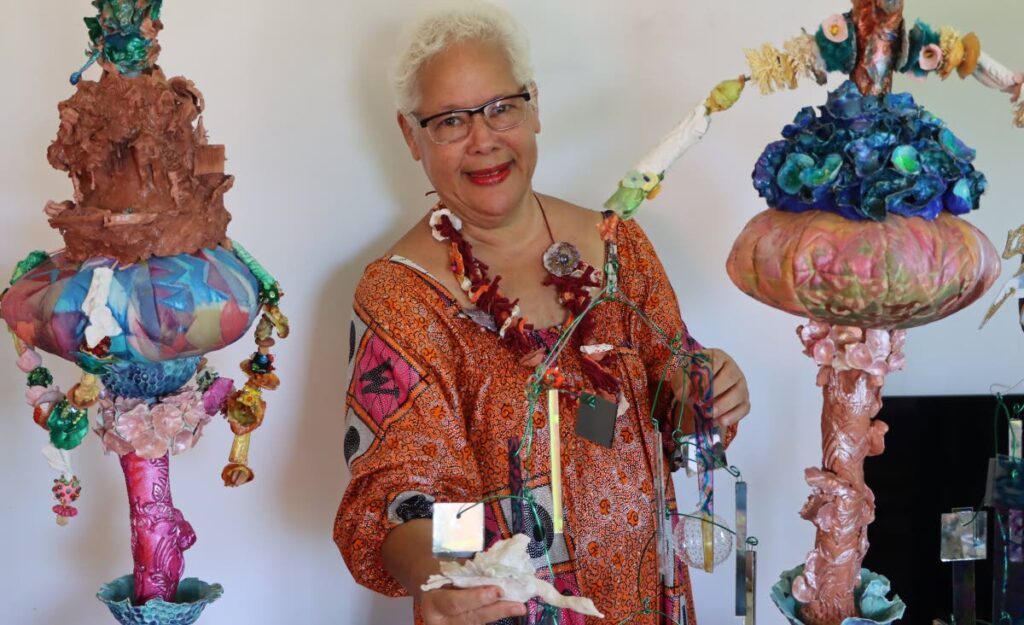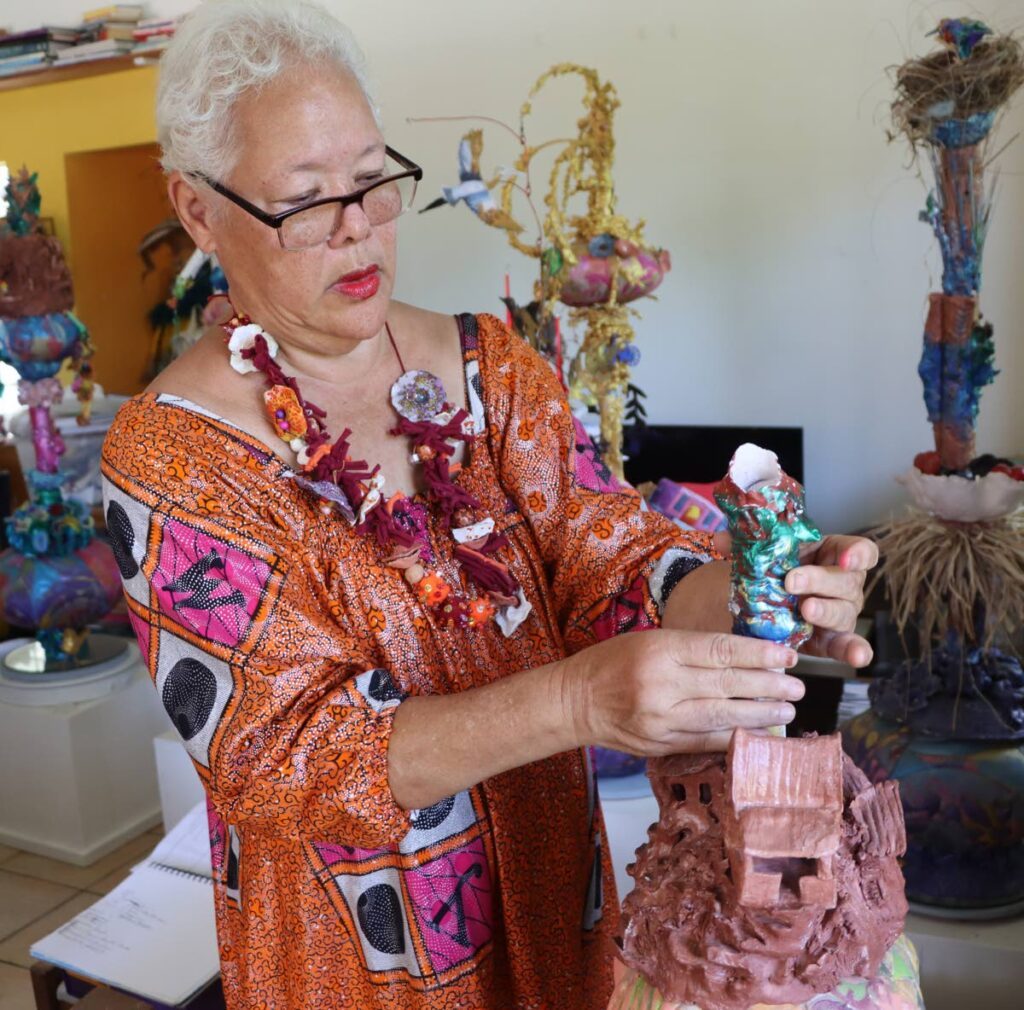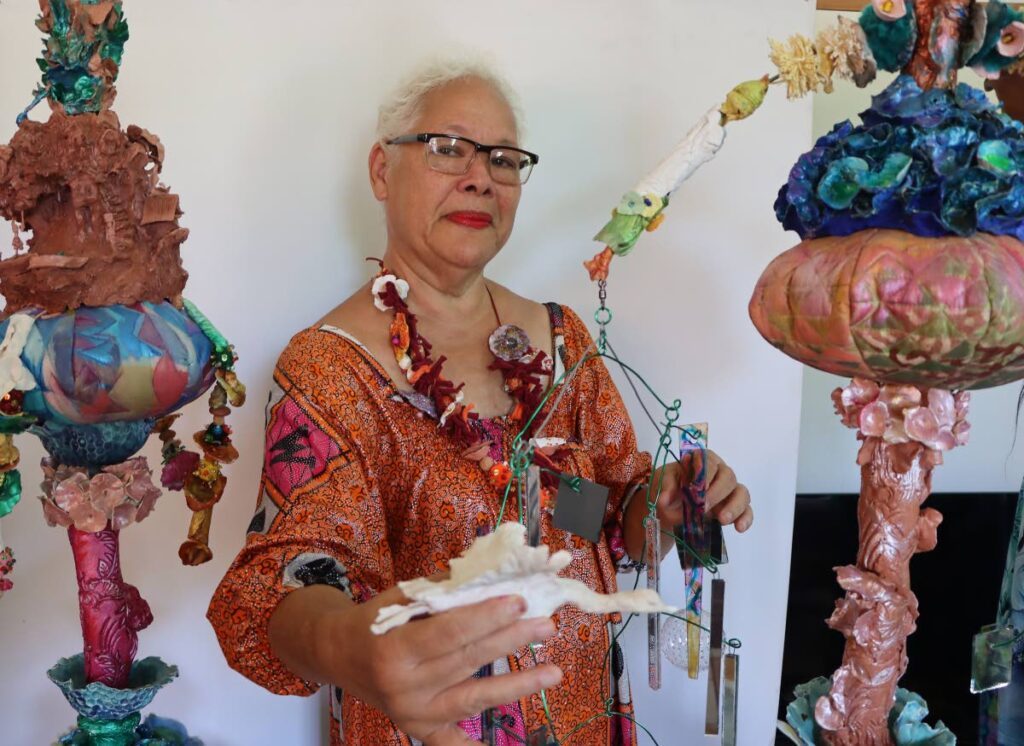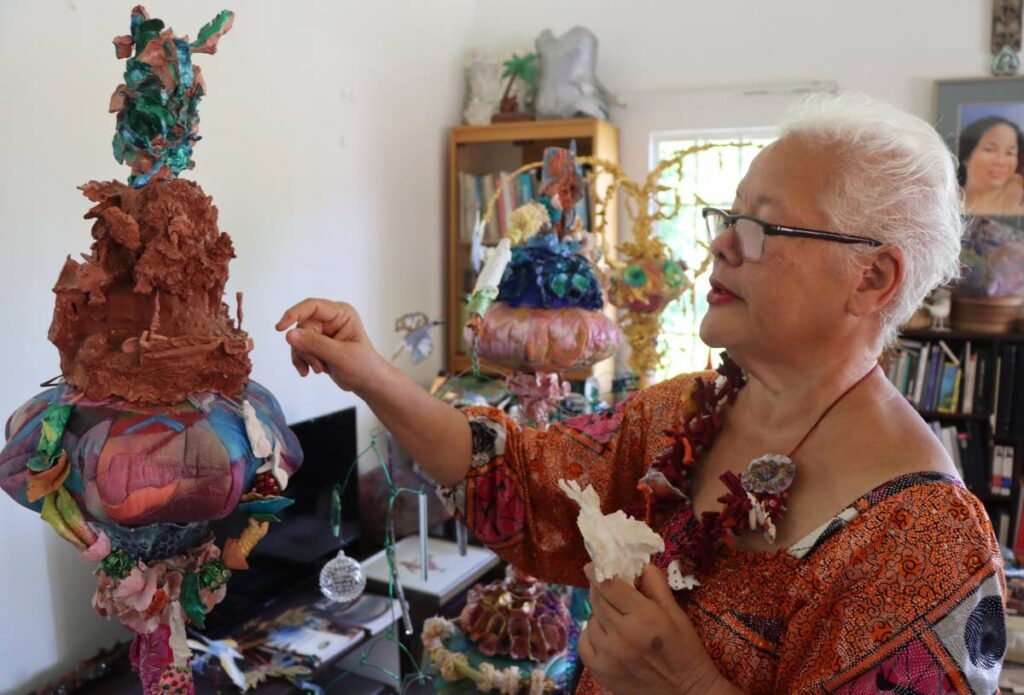Greer Jones-Woodham tells story of Trinidad and Tobago using totems

When most of us think of totems, we visualise birds or animals carved from thick wooden poles and imagine their spiritual significance for the First People, particularly the "Caribs" of Trinidad and the Warao of Venezuela.
But artist Greer Jones-Woodham is finding ways for totems to cross cultural boundaries, and from September 14-18 they will be exhibited at Soft Box Gallery, Alcazar Street, St Clair.
She got the idea of experimenting with totems five years ago while making necklaces out of chunky, hand-made ceramic beads.
“Every time you string a bead, it tells you what to put next. You see the necessary repetition and how to break the repetition. The necklaces dictate a structure, and the totems I envisioned became an enlargement of that process and structure,” Jones-Woodham told WMN.
But no art, she claims, comes out of a vacuum or an isolated event. It is a culmination of experiences.
“The same time I was making jewellery, I was doing a lot of contemplating in public spaces like the Botanic Gardens and the Queen's Park Savannah.”
Just homing in on a tree created a concept of flow. Leaves rustling in the breeze conjured up images of birds, and then birds magically appeared on branches.
“The power of the objects speaks to you. Observations are not static. They move and change,” said Jones-Woodham. “Nature is always a work in progress – just like art. Stories enter objects. It’s like you’re playing chess and every piece has power.”
She suddenly found herself creating clay birds without a tree or nest. They waited for a place to rest in her art. In those early days, as her ideas for creating totems took shape, she knew everything she stood for as an artist would converge on a whole new interpretation of totems.

“I saw my theatre experience as a set designer, my sewing, embroidering, painting and textile work all taking shape as objects not yet connected, and it all brought me peace,” she said.
Then the pieces in isolation began suggesting relationships. The totems were coming together.
“You have a structure – a base that forms the foundation of a story you’re going to tell. I think of the pieces going up from the bottom. When the First People did totems, they believed in the spirituality of the objects. If they were doing animals, objects began shape-shifting.
Her totems tell the story of TT, its beauty and violence. The first totem, In Memoriam, captures the tragic story of battered women.
“It looks at how women have lost their lives. The guns in the totem take on lives of their own. The guns, the crime and objects float about on the totem. A chair turned upside down cascades down a pillar. A bed is thrown into the scene. The guns morph into breadfruit leaves – my way of stopping the guns from firing. My totems use mobiles, so objects move.”
The art is meant for viewers to meditate on the images and draw their own conclusions.
“As the objects in the mobile spin, you see how your own personal narrative fits into the totem.”
The totem became her way of dealing with the fear of crime that has gripped the country.

“There is no way to romanticise the horrific stories we hear about crime. I want to capture that crime without trivialising it, but I also want to celebrate this beautiful country – the flora and fauna and the utopic scenes of mountain life – a house sitting on a mountaintop, women walking up a hill, boats sitting precariously on the edge of the ocean,” she said of another one of her totems.
Her totems – including In Memoriam – may feature houses.
“The house is a metaphor for food, knowledge and safety. It was the first image I drew as a child, and that image has travelled with me throughout my career.”
Some people are puzzled by her new creative direction.
“I get questions like, ‘Where will it fit in my house? Do you encase it?’ I tell them, ‘It will fit wherever it fits – and no, don’t encase it’.”
She said she stopped making art with the primary purpose of sales.
"When I wanted to capture a market, I made fabric, jewellery and clothes. I make no apologies for these totems that fill my own creative spirit.”
Jones-Woodham laments the losses we all share in this country – the loss of space and the loss of lives. She now deals with those feelings of emptiness by reinventing the narrative.
“I still work in theatre to bring life to words; that’s what the totems do for me. They give objects life, significance and they tell their stories.”
Jones-Woodham, a breast cancer survivor, believes contemplating nature and the objects that she conjures up opens up spirituality. This helped her journey to recovery after her operation. She remembers going to the Queen's Park Savannah one day when she was dreading an upcoming doctor’s appointment.

“I looked up and saw a flock of egrets flying towards me, and I felt they were souls.”
That vision morphed into the idea of spirits rising up from abused women.
“When I”m making a totem, it feels like I’m catching a power. I’m feeling the bird’s wings I am sculpting come alive. It’s a form of mysticism. It reminds me of the soulfulness missing from our lives, but it’s still there.”
One of the unnamed totems has shards of glass and mirrors for reflection.
“In this totem, I’m inviting you to look at yourself. There’s no beginning and there’s no end. Images just keep circling.”
This mobile conjures up memories of Jones-Woodham’s early life when she danced with Pauline Clarke in San Fernando, Caribbean School of Dancing, the Astor Johnson and La Chapelle/Douglas companies and the Trinidad Theatre Workshop.
“I understand how the body moves. I watch the mirrors spinning and catch glimpses of a slice of my face.”
Some of the totems are mostly made of clay; some are made of stuffed fabric so it becomes three-dimensional; some are quilted houses. It takes 24 squares to build a house.
“When I put the house together, I embroider or hand-paint it. The houses just come together. I go out and buy a a piece of fabric and needles, and when I come home, the house takes shape. Ideas just flow and translate themselves into another piece of a totem.”
Jones-Woodham has taught art at the International School of Port of Spain UWI and the University of Trinidad and Tobago. She knew when it was time to leave teaching and work on her art full time.
“The birds came calling, and I felt it was ok to make this move. They came into my garden – hummingbirds, yellow and black birds – and made their nests in the trees. They felt safe. I would listen to their conversations.”

The birds are also messengers in the totems. They are objects, but they bring messages of hope, change and individuality.
“So many people want the totems to fit in some kind of criteria, but they don’t fit into anything.
"I’m not mimicking or appropriating First Peoples' art. I’m finding new interpretations for it. You could have a totem like a family tree with objects that represent each person. I can come into a house and watch objects that symbolise the whole house and make that a totem.” .
Of the five totems Jones-Woodham has created (they are constantly evolving) her favourite is called My Country.
“It looks very Indian and African at the same time. It didn’t start out to be that, but that is how it ended up, with gold, orange and fluorescent colours.
"There’s Indian, African, Chinese and white in me, so I’m not polarising myself.”
One of the totems has a pan made out of hand-painted fabric at the base and a house on top.
“Now I have to find what goes in the middle to connect those two images.”
Yet another totem is still in the sketching stage.
“I want to make a necklace to drape around this totem so moving figures can come out of the necklace.”
This totem might capture Carnival.
“The whole notion of the totems makes it Carnivalesque.”
She is opening up to the idea of mysticism and how that is translated into her totems. Certain events make her ponder surreal feelings.
“On the day I was going for my cancer surgery, I said to God, ‘Show me a sign. Show me an image.’ I looked out of the hospital window and saw a white dove in the light. I could see the light coming through the wings. It was transforming.
"We’ve become afraid of those spiritual moments.”
Jones-Woodham says the images and ideas for totems just keep coming to her.
“Creativity is just being in the moment. You don’t decide the moment, you use it. This requires letting go and opening yourself up to new experiences and feelings.”
Pausing, then gazing into the distance, she says, “What is left to enjoy in this country?”
That thought just might end up in a totem.
For more information on the exhibition, call 622-8610 or e-mail softboxgallery@gmail.com


Comments
"Greer Jones-Woodham tells story of Trinidad and Tobago using totems"